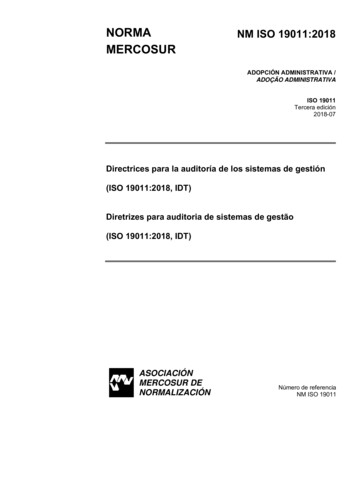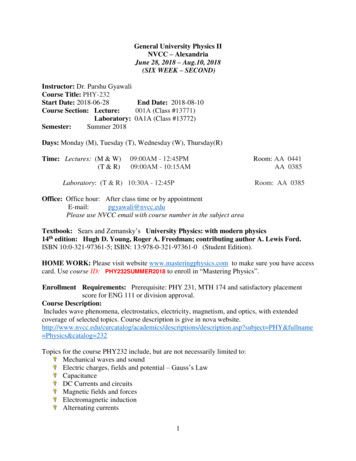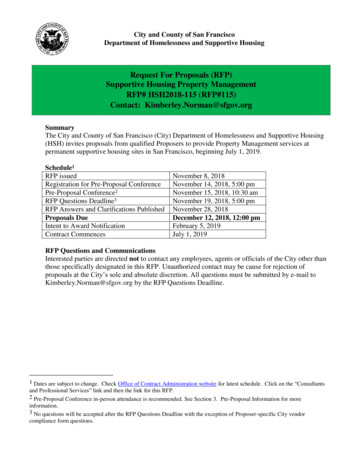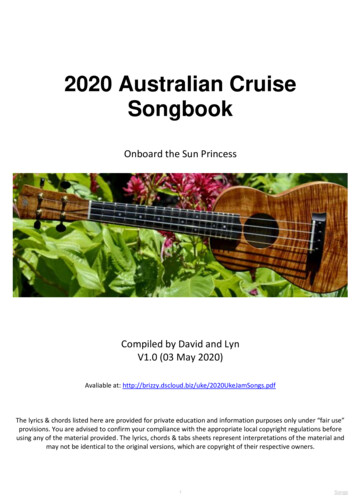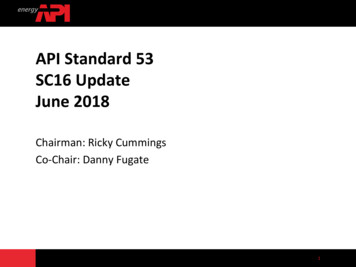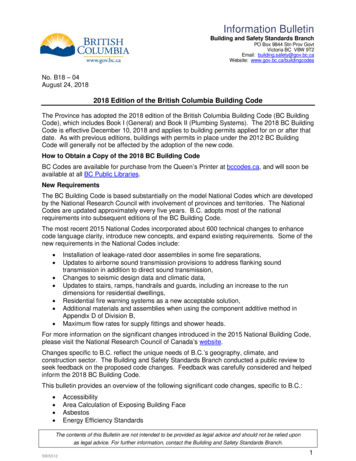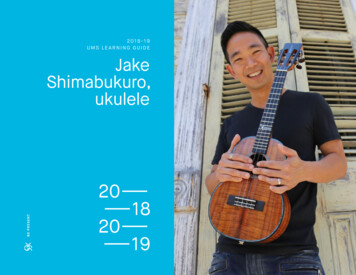
Transcription
2018-19UMS LEARNING GUIDEBE PRESENTJakeShimabukuro,ukuleleBE PRESENT1
Table of Contents0405AT TENDTHE istArt FormPerformanceBeing an Audience MemberArts OnlineRecommended ReadingWriting About Live Performance with Your StudentsAbout UMSCredits and Sponsors
November 7U M S S C H O O L D AY P E R F O R M A N C EJake Shimabukuro,ukuleleWednesday, November 7 // 11amHill AuditoriumBE PRESENT3
AttendComing to your E-mail Inbox!Map and Driving DirectionsLogistical Details (drop-off/pick-up locations)Venue Information7 3 4 . 7 6 4 . 2 5 3 8 ——— U M S . O R GBE PRESENT4
The DetailsACCESSIBILIT YWe aim to maximize accessibility at our performances, and below are detailsregarding this performance’s points of accessibility. If you have furtherquestions, e-mail umsyouth@umich.edu or call 734.615.0122.PARKINGThere is handicapped parking very close to the Power Center on Fletcher Streetand in the parking structure behind the Power Center on Palmer Drive. The firstthree levels of the Palmer Drive structure have 5 handicapped parking spaceson each level next to each elevator. There are a total of 15 handicapped parkingspaces in the garage.WHEELCHAIR ACCESSIBILIT YCourtesy wheelchairs are available for audience members. Hill Auditorium iswheelchair accessible and has 12 seats for audience members with special needs.VENUE ADDRESSHill Auditorium, 825 North University Avenue, Ann Arbor, MI 48109EMERGENCY CONTACT NUMBER734.764.2538ARRIVAL TIMEBetween 10:30-10:50amBATHROOMS ADAADA-compliant toilets are available in the green room (east corner) of the HillAuditorium for both men and women.ENTRYThe front doors are not powered; however, there will be an usher at that dooropening it for all patrons. There is a ramp entrance on the west side of theauditorium.TICKETSWe do not use paper tickets for School Day Performances. We hold schoolreservations at the door and seat groups upon arrival.FOODNo food or drinks (including school lunches) are allowed in the theater.BE PRESENT5
LearnJake Shimabukuro, ukulele7 3 4 . 7 6 4 . 2 5 3 8 ——— U M S . O R GBE PRESENT6
LEARNWhy?Every major artist has that one defining album or performance,but for ukulele master Jake Shimabukuro, his entire career hasbeen filled with such magical achievements. Since he first cameto the world’s attention with his deeply beautiful and originaltake on George Harrison’s “While My Guitar Gently Weeps” ina viral video that dominated YouTube in 2005, the Hawaii-bornShimabukuro has virtually reinvented the four-string instrument,causing many to call him “the Jimi Hendrix of the ukulele.”The ukulele’s distinctive, plinky sound transports us to sunsoaked beaches of Hawaii, where the instrument originated inthe 19th century. Since then, the ukulele has been the centerof traditional Hawaiian music, and it has been popularized inmainstream culture through ukulele covers and contemporarypop hits like Israel Kamakawiwo’ole’s cover of “Over theRainbow/What a Wonderful World” and Jason Mraz’s “I’mYours.” Today, the ukulele’s widespread popularity is readilyapparent; children and adults are picking up the instrumentin huge numbers, ukulele clubs are popping up around theworld, and YouTube is full of ukulele covers inspired by a newgeneration of artists.U M S E D U C AT I O N A R T I S T S I C S TAT E M E N TThe ukulele is a relatively simple and easy-to-learn instrument.It has a small range of just two octaves and a limited palette oftone colors. Despite the instrument’s simplicity and seeminglylimited musical potential, Shimabukuro has exploded theinstrument’s capabilities with dazzling technical and artisticvirtuosity, using the ukulele’s limitations to fuel rather than stiflehis creativity.Shimabukuro represents a rare combination of artistic renegadeand musical ambassador. Speaking about the instrument and hisperformances, Shimabukuro says, “You’ll see families come withtheir little kids, and high school students, and young adults, andgrandmas and grandpas. People from all walks of life can relateto it. Bringing masses together, that’s the power of the uke.” Hispassion for the ukulele is as equally evident when he stretchesthe instrument’s technical boundaries as when he teaches basicchords to a roomful.We hope that Shimabukuro’s captivating passion will inspirestudents at the School Day Performance to learn more about —and maybe even pick up — the ukulele.BE PRESENT7
LEARNWhy?ONLINE: CONNECTING TO THE PERFORMANCEListen to this Spotify playlist exploringJake Shimabukuro’s work and the artof the ukulele.BE PRESENT8
LEARNArtistJAKE SHIMABUKURO: FIVE THINGS TO KNOW010203The ukulele is a four-string musicalinstrument made from wood thatresembles a small classical guitar. Englishspeakers pronounce it as “you-ka-leyley,” but in fact, the spelling of the wordis an anglicized version of the originalHawaiian pronunciation “ju-ke-lei-li.”The ukulele originated in the 19th centuryas the Hawaiian adaptation of twomusical instruments from Portugal – thecavaquinho and the machete – whichwere introduced to Hawaii by Portugueseimmigrants from Madeira and the Azores.Shimabukuro’s wholly unique approach tothe ukulele started early. As a youngstergrowing up in Honolulu, Hawaii, Shimabukurostarted playing the instrument at the ageof four, learning the basics from his mother,Carol, and then developing his craft furtherby studying the likes of musical masters suchas Eddie Kamae, Ohta-San, and Peter Moon.As he matured, Shimabukuro also foundinspiration from guitar players, drummers,pianists, and singers. Even athletes helpedfuel the intensity of his artistic fire.In 2005, Shimabukuro’s touring career really came to life witha video on YouTube. “I didn’t even know what YouTube wasat the time, so I was totally surprised when people startedtelling me they’d seen a video of me playing ‘While My GuitarGently Weeps,’” he says. “Before I got a chance to check itout myself, the video had gone viral and a lot of music industryfolks seemed to know about it. It was crazy!” Shimabukuro’sdeeply beautiful and original take on George Harrison’s loveballad captured colors and moods never associated with theukulele before. The 2006 release of Gently Weeps, whichmixed his own originals with equally adventurous versionsof “Ave Maria” and “The Star-Spangled Banner,” was anunqualified success.0405Shimabukuro’s records have topped the Billboard World MusicCharts on numerous occasions, and as a live performer, he hasplayed with world-renowned orchestras and at prestigiousvenues such as the Hollywood Bowl, Lincoln Center, and theSydney Opera House, as well as music festivals includingBonnaroo, SXSW, the Playboy Jazz Festival, and Fuji RockFestival. He even performed for that rarest of audiences: HerMajesty Queen Elizabeth II. In addition to writing numerousoriginal compositions and releasing several albums,Shimabukuro has also written the entire soundtracks to twoJapanese films, Hula Girls (2007), and the Japanese remake ofSideways (2009).Shimabukuro is the creator of the Four Strings Foundation, which isdedicated to the promotion of music education in US public schools. Thefoundation’s mission is to create opportunities for people of all ages toenjoy the act of making music together through the ukulele and to usethose experiences as a vehicle to personal empowerment and fulfillment.The foundation provides resources and content to teachers, musicprograms, and community organizations that wish to create or broadentheir music programs, and they provide educational workshops and clinicsfeaturing Jake Shimabukuro.Visit fourstringsfoundation.wordpress.com to learn more.BE PRESENT9
LEARNArtistONLINE: GET TING TO KNOW JAKE SHIMABUKUROGo behind the scenes ofShimabukuro’s tour in this video.Follow Jake on Twitter at@JakeShimabukuro or visit hiswebsite at jakeshimabukuro.comBE PRESENT10
LEARNArt FormA R R A N G E M E N T, T R A N S C R I P T I O N , A N D C O M P O S I T I O NJake Shimabukuro draws material from a variety of sources, and isa master of three different but linked ways of generating music:composition, arrangement, and transcription.A musician creates an arrangement (also called a “cover”) asa way of bringing new flavors to a previously composed piece.Arrangements typically retain some of the original composition’srhythmic, harmonic, and melodic frameworks, but use differentinstruments and unique musical concepts to create a freshinterpretation.A transcription is a type of arrangement intended to be extremelyfaithful to the original work. Transcriptions typically involve apiece changing instrumentation, being notated in a new key, or, inthe case of folk music or improvised solos, being written down forthe first time. Transcriptions still bring new ideas to a previouslycomposed piece, but with less freedom than arrangement orcomposition.Composition is the creation of brand-new musical material. Whileno artist can be free of outside artistic influence, composers seekto generate music that is completely unique.BE PRESENT11
LEARNArt FormO N L I N E : A R R A N G E M E N T, T R A N S C R I P T I O N , C O M P O S I T I O NA lot of those are just songsthat I really love. I’d sit athome and work out how toplay some of them on theA R R A N G E M E N T:In arranging Queen’s “Bohemian Rhapsody,”Shimabukuro faced the challenge of reducing a songwritten for four people (and recorded on more than 100separate tracks) for the tiny ukulele. But even the mostcomplex music is no match for Shimabukuro’s virtuosity,as delivered in this TED Talk/performance.ukulele. A lot of it is formy own curiosity. I alwayswondered, ‘Man, what wouldTRANSCRIPTION:In this video, Shimabukuro plays a transcription ofBach’s Invention No. 4 in d minor and speaks about thechallenges and rewards of playing Bach on ukulele.“Bohemian Rhapsody” soundlike on a ukulele?’ And thenit’s my stubborn nature not togive up until I’d figured outCOMPOSITION:Jake Shimabukuro performs his own composition“143 (Kelly’s Song).”how to do it.BE PRESENT12
LEARNPerformanceJ A K E S H I M A B U K U R O, U K U L E L ESometimes I can’t think of a better wayto end my day than coming home andjust strumming my ukulele for a fewminutes. I mean, I joke around and tellpeople that it’s an entire yoga session inone strum, you know?–JAKE SHIMABUKUROBE PRESENT13
LEARNPerformanceJake Shimabukuro,ukuleleWednesday, November 7 // 11amHill AuditoriumJake Shimabukuro can still vividly rememberthe first time he held a ukulele, at age four. Theencounter shaped his destiny and ultimatelygave the world one of the most exceptional andinnovative ukulele players in the history of theinstrument — and one who has drawn comparisonsto musical titans like Jimi Hendrix and Miles Davis.His dazzling fretwork, ambitious repertoire, andwistful melodicism made him an internationalphenomenon on YouTube, when a video of himperforming George Harrison’s “While My GuitarGently Weeps” went viral — one of the first videosto go viral on the platform. He has collaborated withartists as diverse as Yo-Yo Ma, Jimmy Buffett, andBette Midler and breathes fresh life into everythingfrom covers of rock classics and jazz songbookstandards to traditional Hawaiian music and his ownoriginal songs.BE PRESENT14
LEARNPerformanceONLINE: JAKE SHIMABUKUROTo learn more about the ukulele, check outUMS’s infographic on the history of theinstrument. Update the blog post - UkuleleStar Jake Shimabukuro returns to HillAuditorium on November 7, 2018.BE PRESENT15
ConnectBeing an Audience MemberArts OnlineWriting about Live Performances with Your StudentsAbout UMSCredit and Sponsors7 3 4 . 7 6 4 . 2 5 3 8 ——— U M S . O R GBE PRESENT16
CONNECTBeing an audience member No talking, unless audience participation is requested by the performers. Avoid fidgeting and moving around in your seat during the performance.Slumping sideways blocks the view for audience members behind you,and extra movements can be distracting to your neighbors. Do not take flash photography. The flash can be distracting to theperformers on stage. Turn off and put away cell phones and other electronic devices. If you need to cough during the performance, wait for the pausebetween movements of a piece or try to “bury” your cough in a loudpassage of music.AUDIENCE ETIQUET TE 101WHEN SHOULD I CLAP?The audience claps to welcome the performers as they come on stage.The audience also claps at the conclusion of each piece on theprogram, but not between movements of a single piece. This can betricky, because many musical works have several movements withpauses in between. A work’s movements will be listed in the program orannounced at the performance. Not sure when the piece is over? Watchthe conductor, who will lower their hands at the end of the piece.When in doubt, it’s always safe to wait and follow what the rest of theaudience does. If you need assistance, please speak to a UMS usher. Most importantly, relax and enjoy the performance!BE PRESENT17
CONNECTBeing an audience memberENGAGING WITH THE PERFORMANCEEncourage your students to engage with and reflect on the performanceby asking these questions:GLOSSARY: ELEMENTS OF PERFORMANCE How did the performance make you feel?Lighting – location of light, use of darkness, color, movement, light in theaudience What does this performance remind you of?Space – venue/building, stage, distance between objects How does this performance relate to where you live?Sound – sound created by voices or movements of performers andaudience members, the location of the sound (behind the stage oroffstage), use of musical instruments or recorded music During the performance, close your eyes and imagine a “mind movie”using the performance as a soundtrack. What did you see in your mind?Movement – movement of performers, images, objects, or audiencemembers; speed, size, or shape of movements Did the performance tell a specific story?People: What was the
challenges and rewards of playing Bach on ukulele. COMPOSITION: Jake Shimabukuro performs his own composition “143 (Kelly’s Song).” ARRANGEMENT: In arranging Queen’s “Bohemian Rhapsody,” Shimabukuro faced the challenge of reducing a song written for four people (and recorded on more than 100 separate tracks) for the tiny ukulele. But even the most




